
VICTA Changemakers
Blindness Awareness Month
We are Scarlett and Eliza, two blind swimmers who competed at the 2024 Paralympic Games in Paris. From the enjoyment of what started as just a hobby, to one day achieving your dream, our journey through the sport has given us many experiences that we shall never forget, and taught us valuable skills both in and out of the pool. We are sharing our experiences of the Paralympics from a blind athlete’s perspective – not from the sights, but the sounds and feel of the Games. We know that no experiences are alike, and even as sisters who have been on the same journey together, we still have differing strengths and strategies, so…
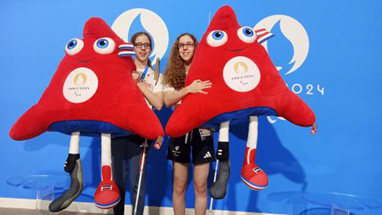
Eliza and Scarlett holding the Paralympic “Phryges” mascot.
London
Before we travelled to Paris, our first stop was London, where we assembled as a para-swimming team, and completed a final week of training at the London Aquatics Centre (LAC). Due to having to train at our club, there wasn’t enough time for us to learn the key routes in advance. Fortunately, we had competed at the British Championships at the LAC in April and as our parents had helped us with orientation for the competition, were familiar with much of the layout. In addition, the route from the hotel to the pool was almost a straight line but, with it being London, was always busy and noisy with people. In the team room at the hotel there were games and activities for when we weren’t training, so we were able to enjoy the Braille scrabble, tactile Connect 4, Braille Uno cards and the Bop-It.
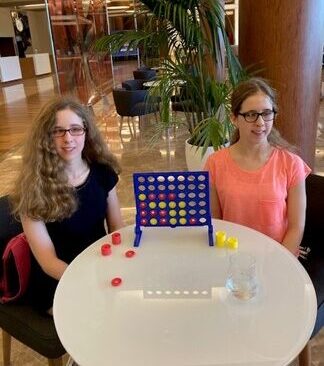
Eliza and Scarlett playing tactile Connect 4 at the pre-games training camp.
Having completed the final week’s training, it was finally time for the Paralympic Games to start so we headed to St Pancras Station to catch the Eurostar train to Paris. We find train stations quite overwhelming due to the bustle of people and the multitude of noises, plus being unfamiliar with the environment. To quickly navigate through the station, we followed behind another athlete’s suitcase, by placing our cane on their case, which worked very well. To go through passport control and baggage scanning, we paired up with another athlete or coach so they could assist. And once we were through, we boarded the train bound for Paris. The quiet of the train was well-received after the noise of the station, and as we left England, we put on audiobooks to relax, excited about our arrival in France.
The Athlete’s Village
Having arrived at the Athlete’s Village in Paris on the Sunday evening, we were very excited. Our first impression of the Village was that the streets were much quieter than in London, but with a more constant flow of people than in our home village. There was the occasional hum of an electric vehicle along the roads; the rattle of wheelchairs along the uneven pavement; many conversations in different languages; and sometimes the sound of a wheelie bag being dragged along. The slight heat of the setting sun and a gentle breeze made it almost a dream arrival into the Village.
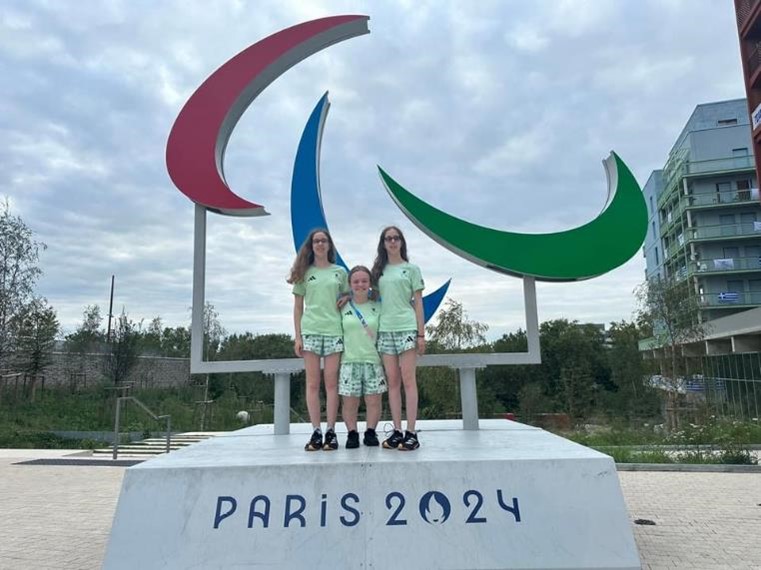
Eliza and Scarlett with fellow swimmer Maisie Summers-Newton at the Paralympic symbol “Agitos” in the Athlete’s Village.
The following day a team manager took us on a tour of the Village so we were aware of its layout and what facilities were there. Along one side you could smell the river and hear it flowing while feeling the wooden boardwalk under your cane. A grassy verge behind you indicated the row of shops were directly in front, and immediately on the corner at the end of our street of apartments, was the coffee shop (where you could hear chatting and smell coffee being made). After this, we started learning key routes, such as from our apartment block to the dining hall, from the apartment block to the transport hub, and the dining hall to the transport hub. Over the duration of the next two weeks, we had learnt almost the entire layout of the Village, but due to the amount of energy it takes to memorise routes through the types of paving you should be on, the number of road crossings, the left/right turns, and any landmarks such as lamp posts, we only started with key routes we would be walking a lot, and initially only started walking these with other athletes or staff until we were fully confident. At usual international swimming competitions, we were only used to having about 400 athletes, so having a Village containing almost ten times this amount meant that the pavements and roads were always busy. It took a lot of mental energy due to the amount of people, as listening out for people took a lot of concentration. There didn’t appear to be any one-way systems or sides to stay on, so when out alone, you had to always be alert for any oncoming voices, wheels or footfall.
The dining hall was very noisy with quite a high roof which caused the sound to echo and amplify more. However, it was split into eight different rooms/sections, which meant that the main area wasn’t too busy, and the noise was slightly reduced, as these were more temporary structures. There was many different foods available, with the ‘world’ and ‘French’ sections offering pastas, cuts of meats, cooked vegetables, rice and fish; ‘Asia’ including many different types of rice, noodles, steamed or stir-fried vegetables, curries and sauces, meats with marinades; and always salad, yoghurts, fruits and cakes. We always went with a team manager or teammate, so they could describe what food was available to eat and also to help guide if it became too busy. Once we had learnt the route to the dining hall, we would meet a team manager on the way who would then support us. With any support we required, we would message the team manager in advance with what we needed, at what time and where we would meet them, which meant that we could have independence but also access support when required.
Over the two weeks of being in the Village we became more confident in venturing about alone. Once we memorised which streets the laundry rooms were on from previous trips there, we were able to find its exact location by the distinct scent of the washing powder that drifted out of their doorways. Likewise, we found the takeaway ‘grab and go’ food place at the end of our street by following the sound of queuing voices, hoping that we joined the back of the queue (sorry to those we went ahead of if not)! People were always friendly around the Village and helped if needed, for instance, someone told us in the ‘grab and go’ queue it was our turn when we didn’t realise the third counter was open. Overall, we really enjoyed our time in the Village, gaining more confidence the more familiar we got with the environment.
The competition venue
A 40-minute bus journey took us from the Village to the competition venue. The buses were often very full so were quite loud and warm. We usually listened to music en-route so as to relax before the couple of hours of hard concentration ahead.
The competition venue was split into two sections: one being the racing area; the second being the prep area, where we would be before racing. Compared to the very humid and uncomfortably stifling environment of most pool-sides, the temperature of this arena was much cooler. You could feel the enormity of the place with it being a converted rugby stadium. One day before racing started, our group coach took us to the top of the stands so we could get a feel for how big the place was. Around 100 steps later, we sat in the top-most row, now the conversations on poolside down below swallowed up by the vastness between us.
Similar to when we had entered the Village, we had a tour of the venue with a team manager before racing started where they showed us around the competition pool, the call-up rooms, the warm-up pool, the GB prep area and where the changing rooms were. The routes were fairly straightforward, although in some cases there were no landmarks to indicate turns or destinations so we had to count the number of steps taken. For instance, the prep area was a large room divided into grids with lots of tape to signal different countries’ prep spaces. We had to count our steps (20, turn left, then 44), as the tape was sadly not tactile, to go from the entrance to the pep spaces to where GB were based, trying not to trample on any other nation’s prep space!
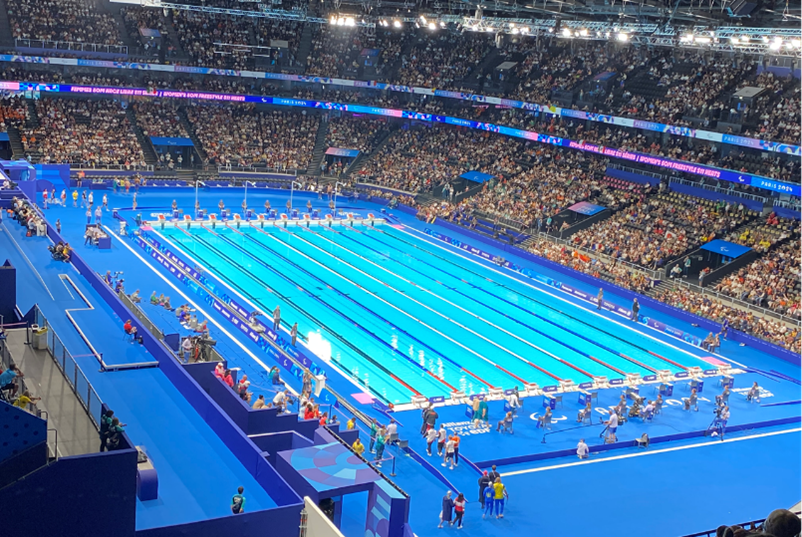
The competition pool with Eliza and Scarlett walking out with other athletes.
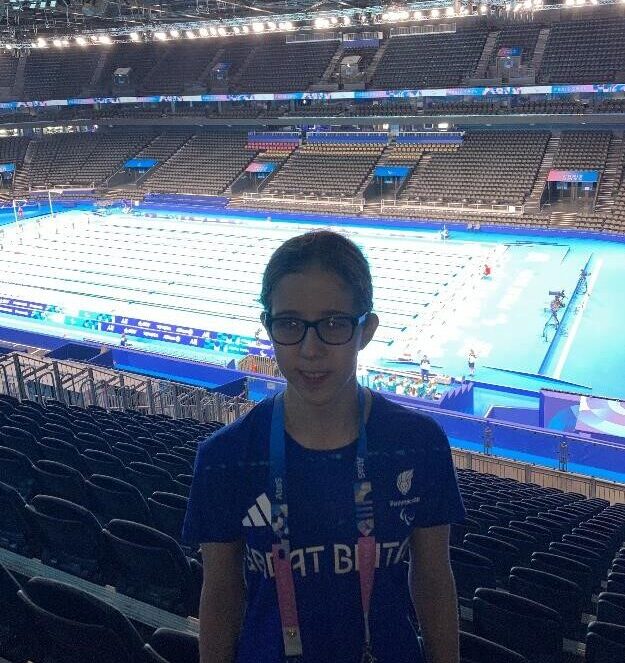
Eliza standing inside the empty La Defense Arena competition pool.
We had boxes surrounding the GB prep area, which we could put our kit in. This meant the floor of the prep area was quite clear, helpfully removing hazards for us to trip over. This was very useful as we knew where we could put our things, and when possible, we were given boxes by the corner of the space so we could find them quickly.
Racing
From the silence in the call-room to the roar of the crowd when we walked out, it was like nothing we had ever experienced before. As most people can see the crowd, their family and friends, we just heard the 15,000 people cheering. It was truly incredible!
As our names were read out, we took in the noise from all four sides. Once we had dived in, you just hear silence, as you are underwater but once our heads broke the surface, we could still hear the crowd in the background. Once touching the wall and hearing the whistle to clear the pool, our tappers would then look through the crowd to see if they could see any of our friends or family. If they spotted them, they would tell us which direction to wave. The energy from the noise of the crowd was something we have never witnessed at a swimming event before, but meant so much to have the support for para swimmers. Racing in front of so many people was a truly amazing experience!
Watch the action on Channel 4 Sport!
Scarlett and Eliza compete in the 400m freestyle s11 final (day 2) – you can watch the other races at the end of this article.
Returning to London
When the time came to leave Paris, we packed our suitcases and were transferred to the train station where we would take the Eurostar. It was very quiet on the bus and the train as most people were still tired, as it was mid-morning, and once again we put our headphones in for the journey. We too were tired, as three weeks of learning routes, competing, being away from familiarity had used a lot of mental energy.
Once we arrived at St. Pancras, it was once again very busy on the station, as all the ParalympicsGB athletes disembarked. People were excited to be home as the chorus of conversations filled the air. People shuffled this way and that across the platform to have photos taken and start moving towards the exits into London. As the crowd of athletes slowly thinned, we followed a teammate’s suitcase ahead of us as we too headed off. From both sides we were greeted with rounds of applause and cheering from volunteers and teammates as we departed, a lovely welcome after an experience of a lifetime.
Footnotes to mention
The ParalympicsGB kit was very tactile, so could be identified by touch. We had a kit colour rota, and each colour had a slightly different texture or design, so we could independently pick our clothes.
General support – Out team manager came on the bus; if we went somewhere unfamiliar in the Village, someone was able to assist and come with us.
Camera – Because we have no vision, we relied on teammates and staff to take photos for us so everything would be in the frame. Maybe for future trips, we will practise taking photos more independently, trying to ensure everything is captured.
Written by Scarlett and Eliza Humphrey





